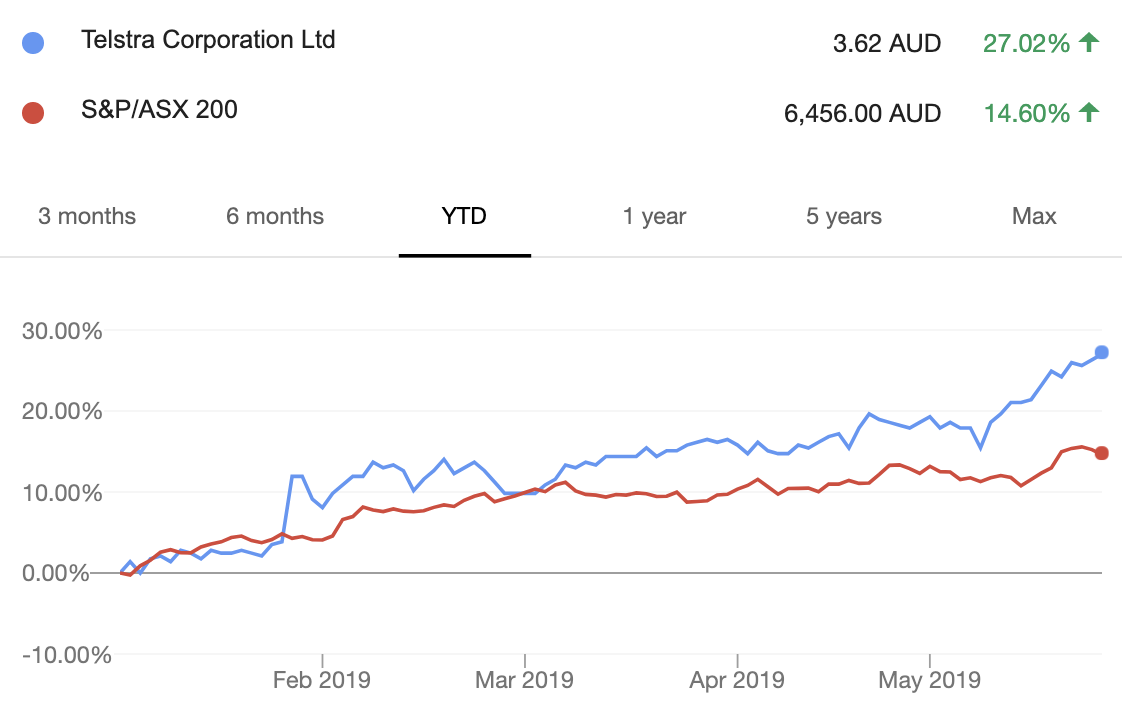The Telstra Corporation Ltd (ASX: TLS) share price has been on a tear in calendar year 2019. Just take a look at the following chart comparing Telstra shares to the ASX 200 (INDEXASX: XJO)…
Telstra Share Price V ASX 200

Including Telstra’s fully franked dividends — though they were cut — its shares have nearly doubled the return of the ASX 200, so far. In fact, it has outpaced BHP Group Ltd (ASX: BHP) and even the mighty CSL Limited (ASX: CSL).
What Does Telstra Do?
Telstra is Australia’s oldest telecommunications business, having built the first telegraph line in the 1800s.
As of 2019, Telstra provides more than 17 million retail mobile services, around 5 million retail fixed voice services (e.g. home phones) and over 3 million broadband services. It also has meaningful operations in eHealth, network applications and subsea cabling.
Serially Mediocre?
Starting in 1997, the Australian Government sold Telstra to investors by listing its shares on the ASX. The second major batch of Government share sales was called “T2”. It was conducted in 1999 at $7.40 per share.
Telstra shares have never reached the heights achieved before the turn of the century.
Starting in 2015, when Telstra shares were trading as high as $6.50, it seemed investors began to lose enthusiasm for our country’s largest telco. By 2018 it hit a low of around $2.60 — a 60% haircut.
With its shares still a long way off their all-time-high, I think long-term investors need to carefully consider what’s changed and whether the current price of $3.50 is offering enough upside hold onto Telstra shares.
Got Moat?
I think a decision to buy, hold or sell Telstra shares should be based upon your assessment of its competitive advantage or ‘moat’.
‘Moat’ is a word the Rask Australia team and I use — a lot. Loosely, a ‘moat’ is a term which refers to the competitive strength of a business. It’s the intrinsic feature of a business (e.g. brand, size, IP, etc.) that enables it to earn better returns than the competition. The word comes from medieval times when a ring of water would surround and protect a castle from attack.
In my opinion, Telstra’s moat was at its widest/strongest in 1997 — when the Government sold the shares to the public. Today, Telstra is faced with increasing competitive threats in broadband, thanks to the NBN Co rollout.
On a positive note, the rollout of its superfast 5G mobile network should at least cement its position as one of the two leaders in the telco sector — alongside Optus. At risk of using too much finance jargon, I believe the 5G mobile network rollout should enable Telstra to earn a decent return on capital (ROIC) for some time yet. Meaning, it should earn more than its cost of capital (WACC) at least until TPG Telecom Ltd (ASX: TPM) and/or Vodafone Australia come to the party.
Buy, Hold or Sell?
I’ve said it time and again but I believe 5G mobile will ‘leapfrog’ the National Broadband Network (NBN) because it’s a faster, more secure and flexible technology than the NBN. This is good for Telstra, its near-term profits and, of course, dividends.
However, the 5G network comes with a big price tag and execution risk. Therefore, I believe the risk of investing in Telstra for the long run has gone up and I would much rather see it paying down debt than issuing dividends to shareholders. It’s on my watchlist for now and that’s where it’ll stay, for now.
If you want to know the names of two ASX shares I would consider buying today, keep reading below…
[ls_content_block id=”14947″ para=”paragraphs”]
Disclosure: At the time of writing, Owen does not have a financial interest in any of the companies mentioned.






